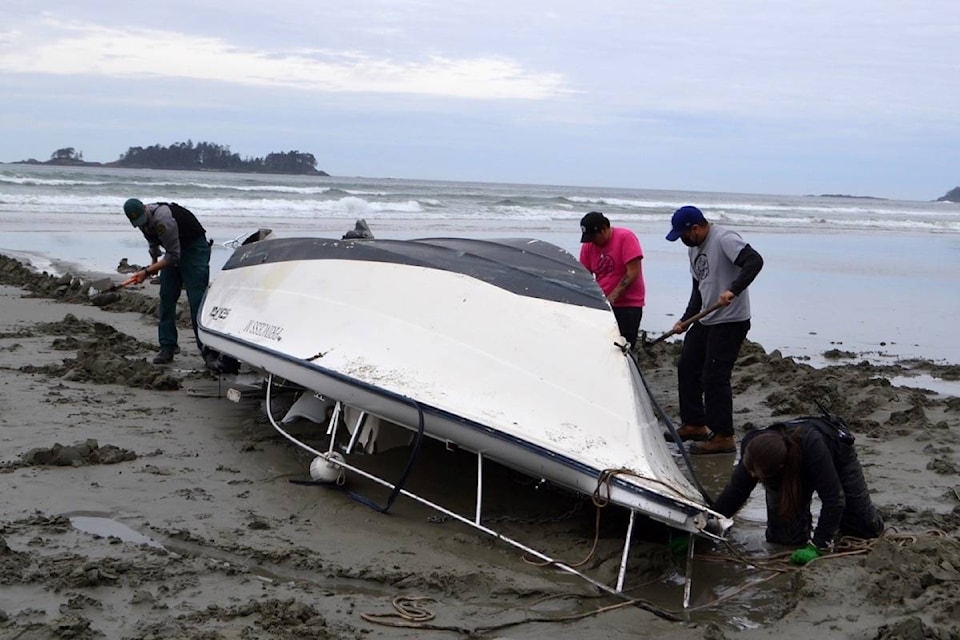Days after losing his boat in a volunteer rescue mission off the shores of the Pacific Rim National Park Reserve, Tla-o-qui-aht First Nation’s emergency operations manager is questioning the Canadian Coast Guard.
Elmer Frank says the CCG Tofino Lifeboat Station could have easily responded to a May 1 distress call, but instead left the rescue to other vessels. As a result, Frank’s efforts to save two elderly fishermen with a dead motor ended with his own 21-foot speedboat capsizing.
While everyone made it safely back to shore that night, Frank is scratching his head in confusion.
“It seems like they spend a lot more resources on my dead boat then they did when somebodies’ lives were actually at risk. They had a helicopter go out and do a search for the derelict boat,” he said.
Frank said he had just returned from a day on the water when he received a call from his nephew about a vessel in distress.
“My boat was on land and I had the trailer behind my house. We had to re-hook it up and tow it to Tofino, my brother (Bruce) followed me into Tofino, I had to stop at the fuel station first and get some fuel,” said Frank, who paid for the fuel out-of-pocket.
Frank, in his Princess M, and his brother in another vessel, the Hannah Jay, were able to successfully locate the boat — the Reel Cowboy, which was in mechanical difficulty — and begin a tow.
“The waves were six to eight feet high with white caps on top. Five to six seconds apart makes for rough seas. The gusts were up to 25 knots. It was not good conditions,” said Frank.
A wave came over the stern of the Princess M and filled one of the hatch covers.
“It filled up fairly quickly. It just takes that one wave. The pump wasn’t working so I knew that we had to do something. My batteries were submerged underwater and I knew things were going to start going down and start shutting down,” Frank said. He called the Coast Guard, abandoned his boat, and jumped on to the Hannah Jay.
“Within seconds my boat rolled over and sank,” he said, adding that they were going to tow it but decided to cut it loose and go back for the Reel Cowboy.
In response to the escalating situation, the Joint Rescue Coordination Centre dispatched the CCGS Cape Ann and Fast Rescue Craft from Tofino station, who took over the tow when they arrived.
A day later, the Princess M was spotted sinking in the sand at south Florencia Bay in the Pacific Rim National Park Reserve. On May 5, Parks Canada teamed up with Tla-o-qui-aht Tribal Parks members and Kestrel Helicopter to retrieve the Princess M from the high tide line.
In an email to the Westerly, Canadian Coast Guard communications advisor Michelle Imbeau said the CCG response was based on initial contact stating the Reel Cowboy had broken down an was requesting a tow, but was not in danger. They were requesting a tow due to a mechanical issue. The Coast Guard broadcast a request for assistance on their behalf and the Hannah J and the Princess M responded.
“The Reel Cowboy took the appropriate steps to try to arrange a tow themselves. The Search and Rescue (SAR) system depends on local resources, VOO, including friends and family, to help assist in low risk situations. This way, the Canadian Coast Guard assets are then available for higher risk, life threatening SAR situations,” continues the CCG statement.
Imbeau went on to note that the MCTS had clear and constant communication with the Reel Cowboy and that when the Reel Cowboy indicated that they had assistance coming, Coast Guard had no way of knowing how long the vessels would take to respond.
According to the CCG, the Joint Rescue Coordination Centre (JRCC) had a number of incidents along the coast on May 1. Two of the calls were life threatening incidents.
According to Parks Canada, Frank’s derelict boat is not believed to have caused any significant impacts to the environment.
“The decision to use a helicopter to remove the vessel means the removal process is quick and has a lower environmental impact than other options available to the park reserve,” says Parks Canada communication officer Emma Badgery.
While Frank expressed his appreciation for the support he’s received from Parks Canada to salvage his boat, his concerns for how CCG responded to the May 1 incident persist.
“[Tla-o-qui-aht] are a volunteer emergency search and rescue. We use our own equipment most of the time. People know to contact us when there is no response from Coast Guard, and there have been a few instances where we’ve had to wait and go through the bureaucratic process,” he said.
nora.omalley@westerlynews.ca
Like us on Facebook and follow us on Twitter
READ: Two B.C. Indigenous Coast Guard auxiliary units receive big financial boost
READ: Nine derelict vessels to be removed from Ucluelet Inlet as part of massive $2.5M cleanup effort
